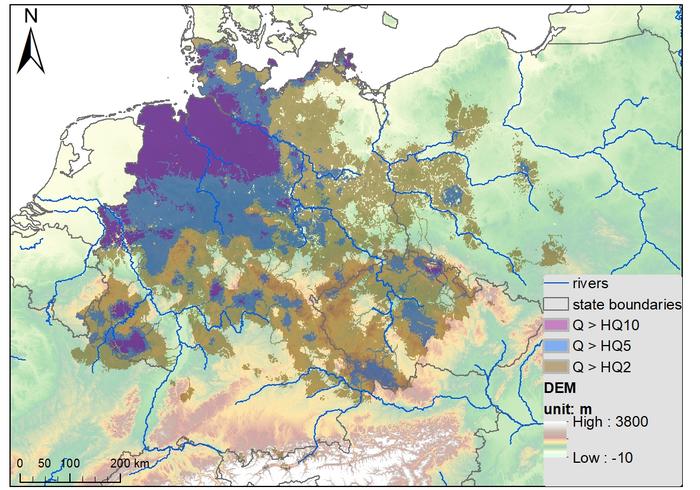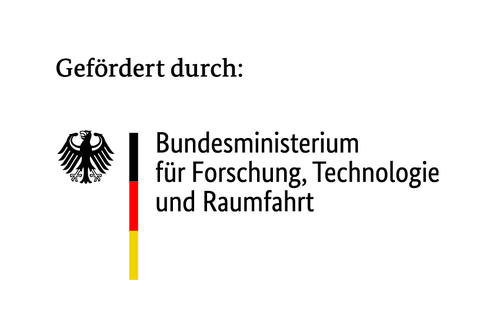Weihnachtshochwasser 2023
Zwischen dem 19. Dezember 2023 und 5. Januar 2024 wurden im nördlichen Teil Deutschlands hohe Niederschlagsmengen verzeichnet. In der Folge entstand eine großräumige Hochwasserlage in weiten Teilen Nordwestdeutschlands.
11.03.2024
Räumliche Ausdehnung des Winterhochwassers 2023/24. In den eingefärbten Bereichen überstiegen die Abflussspitzen im Zeitraum von 14 Tagen um den 25. Dezember 2023 die Schwellenwerte der Wiederkehrzeiten von 2, 5 und 10 Jahren (HQ2, HQ5, HQ10).
Hochwasserlage Dezember 2023 bis Januar 2024
Zwischen dem 19. Dezember 2023 und 5. Januar 2024 wurden im nördlichen Teil Deutschlands hohe Niederschlagsmengen verzeichnet. In der Folge entstand eine großräumige Hochwasserlage in weiten Teilen Nordwestdeutschlands.
Eine hydro-klimatologische Einordnung des Niederschlagsereignisses wurde vom Deutschen Wetterdienst (DWD) vorgenommen und in Form eines Berichts veröffentlicht. Der Schwerpunkt des hier vorgelegten ClimXtreme-Berichts besteht darin, einzelne Aspekte sowohl der Dauerniederschläge als auch des dadurch verursachten Hochwassers aus der Perspektive des Forschungsprojektes ClimXtreme näher zu betrachten. Er ergänzt somit den DWD-Bericht um Ergebnisse, welche mithilfe von Methoden gewonnen wurden, die im Projekt ClimXtreme entwickelt bzw. weiterentwickelt wurden und unabhängig vom hier untersuchten Ereignis für aktuelle Forschungsfragen verwendet werden.
Zusammenfassung
-
Ab Weihnachten 2023 kam es zu einer Hochwassersituation vor allem im Bereich der Flüsse Ems, Weser und Elbe, welche bis in den Januar 2024 hinein zu einer angespannten Lage vor allem in weiten Teilen Nordwestdeutschlands führte.
-
Dieses Winterhochwasser wurde ausgelöst durch großräumige Dauerniederschläge vor allem in Norddeutschland über Weihnachten 2023 (19.-25.12.2023) und verstärkt durch nachfolgende, wenn auch schwächere Niederschlagsereignisse bis Anfang Januar 2024, welche darüber hinaus auf bereits gesättigte Böden trafen.
-
Die Ungewöhnlichkeit des Weihnachtsniederschlagsereignisses bestand in seiner großen räumlichen Ausdehnung und langen zeitlichen Andauer von sieben Tagen. Es hing zusammen mit einer Wetterlage (charakterisiert durch ein ausgedehntes Tiefdrucksystem mit Zentrum über Südskandinavien), welche an sich nicht außergewöhnlich war, jedoch extrem lange andauerte.
-
Das spezifische räumliche Muster dieses einwöchigen Niederschlagsereignisses war auch in der Vergangenheit sowohl mit ergiebigen Dauerniederschlägen als auch mit der zuvor erwähnten Wetterlage assoziiert.
-
Die nachfolgenden Niederschlagsereignisse Ende Dezember und Anfang Januar waren für sich betrachtet wesentlich schwächer. Deren zeitliches Zusammenspiel mit dem vorherigen Weihnachtsereignis führte jedoch dazu, dass gebietsweise über lange Zeiträume von bis zu zweieinhalb Wochen extreme mittlere Niederschlagsintensitäten auftraten.
-
Das Hochwasser als Auswirkung der Niederschläge war ebenfalls im Wesentlichen durch seine große räumliche Ausdehnung charakterisiert, nur vereinzelt wurden extreme Flusspegelstände gemessen. Unter allen Hochwassern in Deutschland seit 1955 (für welche die Abflüsse über zwei Wochen eine Wiederkehrzeit von mindestens 10 Jahren aufwiesen) rangiert die räumliche Ausdehnung des Weihnachtshochwassers 2023 mit gut 100.000 km² auf Platz 9. Die räumliche Ausdehnung ist hierbei nicht die Überflutungsfläche, sondern die Fläche, in der die Hochwasserabflüsse einen bestimmten Schwellenwert überschreiten.
-
Die Überflutungsfläche selbst erreichte eine Ausdehnung von ca. 1000 km² und betraf mehr als 40 Landkreise, vor allem in Niedersachsen und Bremen, aber auch in Teilen Hessens und Nordrhein-Westfalens. Betroffen waren dabei, je nach Abschätzung, 18.000 bis 30.000 Personen, rund 2000 Gebäude, 4,6 km² bebaute Fläche und 470 km Straßen.
-
Die im Dezember 2023 gemessene Monatsniederschlagssumme von 164 mm (über einem besonders von den Niederschlägen betroffenen Gebiet in Niedersachsen: 51,5°N - 53,5°N, 8,0°O - 11,0°O) tritt in den Wintermonaten im heutigen Klima durchschnittlich nur ca. alle 120 Jahre auf. Eine Attributionsstudie des Deutschen Wetterdienstes (DWD) zeigt, dass sich die Wahrscheinlichkeit für ein Ereignis dieser Intensität aufgrund der bisherigen Klimaerwärmung von 1,2° C (seit etwa 1900) um den Faktor 1,8 (Ergebnisspanne: 0,1 bis 140) erhöht hat, und dass sich diese Wahrscheinlichkeit im Falle eines 2 °C wärmeren Klimas, d.h. einer zusätzlichen Erwärmung um weitere 0,8 °C, nochmals erhöhen wird. Die Studie zeigt jedoch auch, dass diese Abschätzungen mit großen Unsicherheiten verbunden sind. Dennoch sind diese Abschätzungen konsistent mit den Ergebnissen verschiedener Studien, welche sowohl eine Zunahme des mittleren Winterniederschlags zeigen als auch eine Intensivierung extremer Niederschlagsereignisse im nördlichen Mitteleuropa.
Um den vollständigen Bericht aufzurufen, klicken Sie bitte auf den folgenden Link.



